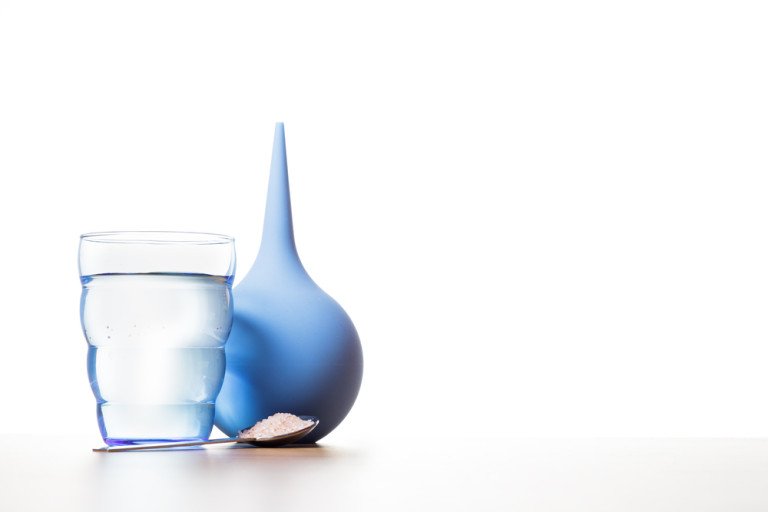
Sinus infections, also known as sinusitis, can make life miserable for sufferers. Your sinuses are located above your eyebrows flanking the bridge of your nose and in your cheeks just below your eyes. These pockets, commonly referred to as nasal passages, should be filled with air.
When people get a cold or suffer from seasonal allergies or allergic rhinitis the nasal passages can fill with mucus. If there are bacteria and germs in the mucus a sinus infection can occur, which will exacerbate inflammation and the many symptoms associated with it.
Unfortunately, these symptoms can stick around for a while. Acute sinusitis can come on fast and last for a couple weeks to a full month. Subacute sinusitis can potentially last for months. Some unlucky people experience chronic or recurrent sinusitis, meaning their nasal passages are blocked for longer than 12 weeks or multiple times each year.
If you’re experiencing these symptoms, you’re not alone. 35 million Americans (approximately 10 percent of the population) are afflicted with sinusitis annually.
Common symptoms include:
- Extreme, sometimes even painful pressure in the face where the nasal passages are located
- Potentially stuffed up or runny nose, coughing and congestion
- Oral pain, as the nasal passages are close to the teeth
- Fever, fatigue, loss of smell and even bad breath
- Thick green or yellow nasal drainage
Treatment Options
Decongestants can be used in the short term but shouldn’t be used for more than three consecutive days. Nasal spray decongestants can actually make you more congested and can even lead to withdrawal symptoms.
Steam is also a popular at-home treatment method that helps some sufferers. You can use a vaporizer, run a hot shower and breathe in the steam in your bathroom, or boil a pan of water and inhale the steam rising from it. (Just be careful the water isn’t too hot when you do so.)
In a study that looked at treatment options for chronic sinus problems, steam was found to help reduce headaches but didn’t provide significant long-term improvements of the underlying congestion. The same study found nasal irrigation for sinus infections provided better treatment results for more participants in the long run.
How Does Nasal Irrigation Work?
Nasal irrigation involves pouring a saline (saltwater) solution in one nostril and letting it flow through your nasal cavities until it drains out the other nostril. The draining saline should, in theory, take with it bacteria-filled mucus and any allergens that are caught inside. Nasal irrigation for sinus infections is intended to decongest the nasal passages, improve your ability to breathe, and open your sinuses back up.
Here’s how we at Allergy & ENT Associates suggest performing nasal irrigation for a sinus infection if you’re looking for a treatment you can do at home.
- Create the saline mixture using a quart of clean water. It doesn’t need to be boiled.
- Add two to three large teaspoons of pickling or canning salt. Do not use table salt, as it sometimes contains additives. Add a teaspoon of baking soda. If you are making a saline solution for a child, you may want to use less salt at first until they are accustomed to the irrigation.
- Stir or shake the solution to ensure it is thoroughly mixed.
- Pour the water into a clean bowl. It can be warmed up slightly, but it shouldn’t be hot.
- Fill a bulb/ear syringe or a Waterpik® with the solution. Don’t put a previously used syringe into the bowl with the original solution to avoid contamination.
- Get in the shower or lean over the sink and squirt the solution into each nostril. Try to aim at the back of the head as opposed to the top. We suggest using a quantity equivalent to three full bulb syringes per nostril.
- Repeat this process up to three times a day when you are congested.
If you are going to perform nasal irrigation for sinus infections several times over the course of several days, create a fresh saline mixture each day. You or your child may experience a slight burning sensation the first few times you perform the nasal irrigation, but this sensation fades after repeat applications for most people. You may want to use a sterilized nasal steroid spray bottle for children.
If you or your child is also currently prescribed a nasal steroid, perform nasal irrigation before administering the steroid. It will be more effectively absorbed once the membranes in the nasal passages are cleaned and as decongested as possible.
Get Treated for Your Sinusitis or Sinus Infection at Allergy & ENT Associates
If you or someone in your family is struggling with consistent sinus congestion, consider scheduling an appointment with Allergy & ENT Associates. Our experienced and compassionate ear, nose, and throat experts provide exceptional diagnosis and treatment solutions throughout the Houston area such as Baytown, Cypress, Spring, and many more locations. We would be happy to offer knowledgeable guidance on home remedies and treatments that may alleviate some symptoms and make life more tolerable.
Schedule an appointment by calling (713) MY-SINUS today!
1https://www.webmd.com/allergies/sinusitis-and-sinus-infection#1
2https://www.webmd.com/allergies/features/nasal-spray-are-you-overdoing-it#1
3http://www.cmaj.ca/content/early/2016/07/18/cmaj.160362



